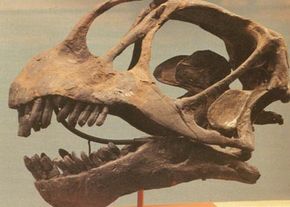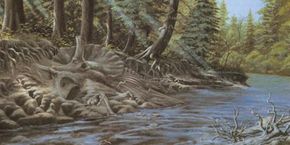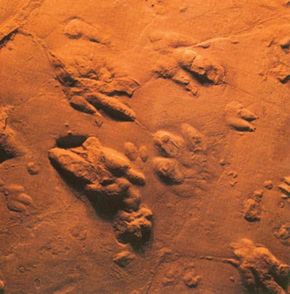Quck answer
Dinosaur bones are the remains of prehistoric animals that lived millions of years ago. These bones are important because they provide scientists with information about the anatomy, behavior, and evolution of dinosaurs. Paleontologists use various techniques to study dinosaur bones, including CT scans, X-rays, and microscopes. They also compare the bones to those of modern animals to better understand how dinosaurs lived and moved. Dinosaur bones have been found all over the world, and new discoveries continue to shed light on these fascinating creatures.
Extinct Creatures

Apatosaurus skull
American Museum of Natural History
Our understanding of dinosaurs is based on their fossilized remains that were left behind on earth. However, only a small amount of dinosaur material has been naturally fossilized, and even then, nature itself can pose a threat to the fossils. Wind and weather can cause damage to the fragile fossils, but at the same time, erosion can expose them for collectors and paleontologists to discover.
Scientists analyze dinosaur skeletons to learn about their behavior and appearance. The skull is particularly significant as a dinosaur’s teeth can provide information about whether it was an advanced or primitive dinosaur, what it ate, and whether it consumed soft or hard plants. The skull can also provide clues about the size of its brain, its eyesight, hearing, and sense of smell. Moreover, the shape of a dinosaur’s skull can reveal its relation to other dinosaurs and its place in the family tree.
Though the skull is important, paleontologists can still learn a lot about a dinosaur skeleton without a head; many skeletons have been found without skulls. Additionally, there are other indicators that dinosaurs left behind, which offer information about their lifestyles and habits. Dinosaur trackways, nests, and eggs have been discovered by scientists. However, there is still much that remains unknown. The fossil record is incomplete and can be misleading, and paleontologists continue to search for other clues that will help them learn more about dinosaurs.
The Formation of Dinosaur Fossils

Triceratops skeleton on the river’s edge
Chicago Academy of Sciences
The term “fossilized” is significant. Paleontologists do not find the actual dinosaur bones, but rather their stony replicas. Fossil bones are created when bone molecules are slowly replaced by mineral molecules in ground water. This process sometimes preserves even the delicate cell structure of the bones. Other times, the bones completely dissolve, leaving only their imprint on the rocks.
Teeth and bones are the most resilient parts of a vertebrate’s body. They can survive long after the animal’s soft parts have decayed or been eaten. Skeletal remains, except for fossilized footprints, are the most common fossils. Unfortunately, only a few animals ever become fossilized, compared to the millions that existed.
Animals rarely die in a location where they can be fossilized. A recently deceased animal that remains above ground will be dissolved by the chemicals in soil and converted into plant food. This is why the bodies of even large animals are seldom found in wooded areas, and why fossils are most often found in deserts and other “bone-dry” places where there are not many plants.
In order for a skeleton to become a fossil, a layer of sediment must rapidly cover the body. This prevents the skeleton from being destroyed by other animals or natural forces. Over thousands and millions of years, this sediment hardens into a protective layer of rock, such as shale, siltstone, mudstone, or sandstone.
Dinosaurs may have had their bones covered by sediment in still water or brought in by air such as volcanic ash falls and dust storms. However, only a small percentage of the world’s land area was suitable for skeletons to become fossils. As a result, many species of dinosaurs lived in areas where no fossils could form, resulting in many evolutionary “missing links” between groups of dinosaurs. Therefore, the fossil record provides an incomplete picture of dinosaurs.
The fossil record can provide large amounts of information, but it is also incomplete and misleading. Scientists must keep these issues in mind when using the fossil record to draw conclusions about dinosaurs and their lifestyles. Small vertebrates are scarce in the fossil record as large, heavy bones are more likely to be preserved than small, lightly built bones. This does not necessarily mean that big dinosaurs dominated the landscape and there were fewer small animals. Additionally, the rocks that contain dinosaur fossils must be accessible for the fossils to be found. Many dinosaur-bearing formations have eroded over time, and their fossils have been lost forever. Furthermore, mistakes made by scientists and paleontologists can mislead researchers about dinosaurs. Researchers were previously only interested in well-preserved skeletons that could be displayed in museums, and some museum specimens are useless because important information was recorded incorrectly or not at all.
Therefore, our knowledge of dinosaurs comes from an incomplete fossil record and the imperfect people who study it. Nonetheless, the fossil record still provides valuable information about dinosaurs.
Appearance and Behavior of Dinosaurs

The Royal Ontario Museum’s exhibit of Lamebeosaurus showcases how almost complete fossil skeletons of dinosaurs can provide insight into their size, weight, and appearance. The cell structure of fossilized dinosaur bones can also reveal information about their biology, such as how fast they grew and whether they were warm-blooded or cold-blooded. Though muscle tissue is rarely preserved, clues about how dinosaurs moved can be found in the traces of ligaments and muscle scars on the bones. Fossilized bones may even show evidence of bone diseases and predator tooth marks. Dinosaurs’ teeth and stomach contents can also provide information about their diets. The “stomach stones” and coprolites (fossilized droppings) of some dinosaurs have been preserved, shedding light on their eating habits. While no dinosaur has been found with feather traces, skin impressions on well-preserved skeletons offer a glimpse into what dinosaur skin looked like. By studying the locations and distribution of dinosaur bones, scientists can also learn about their habitats and lifestyles. For example, the number of predators and prey in a certain area can reveal the metabolism of predatory dinosaurs and whether they were warm-blooded.
Dinosaur Tracks

Dinosaur State Park in Nova Scotia has uncovered numerous fossilized dinosaur footprints, which are more common than skeletal remains. Footprints can reveal how the trackmakers walked, ran, and even swam. Large theropod dinosaurs were known to roam alone or in small groups, while smaller dinosaurs often traveled in herds, leaving many directionless footprints behind. It’s believed that large sauropods also lived in herds. Paleontologists are still studying trackways to determine whether dinosaurs migrated along “highways” in search of food. Though footprints don’t provide many details about what the dinosaurs looked like or what species they belonged to, the skin texture of their feet can sometimes be imprinted.
To estimate the speed of dinosaurs, scientists can measure their stride lengths and footprint sizes and compare them to modern animals. Typically, dinosaurs walked at speeds of four to five miles per hour, although larger sauropods walked at a slower pace of two to three miles per hour. Since animals cannot maintain top speeds for extended periods, tracks of fast-running dinosaurs are scarce. However, theropods’ estimated speeds could have been more than 30 miles per hour, and ornithomimids may have been faster than ostriches.
Dinosaur eggs are rare fossils, usually found in Mongolia, China, India, France, and South America. While they have provided insight into dinosaur nest structures, recent discoveries of nests, nurseries, eggs, embryos, hatchlings, nestlings, and juveniles in Montana have expanded our knowledge. The discovery of helpless hatchlings indicates that they required parental care to survive. The eggs of species that required parental care were found smashed, while those that could care for themselves remained unbroken. Scientists study the sizes of dinosaurs in nurseries to determine how long it took for a particular species to grow big enough to leave the nursery. Unfortunately, nest structures and eggs have been found for only a small number of species.
Dinosaurs evolved special skeletal structures, including horns, frills, sailbacks, domed skulls, cranial crests, plates, and spines. These structures may have been for display, regulation of body heat, making noise, and defense. Dinosaurs had large eyes and were closely related to birds and crocodiles, so their special skeletal structures may have been brightly colored or boldly patterned. Blood vessels ran through some of the structures, allowing dinosaurs to regulate heat loss or gain and change the structure’s color by changing the blood flow, which could express their emotional state to others of their kind.
Birds, crocodiles, and even dinosaurs had excellent hearing, as evidenced by the delicate bony structures of their middle and inner ears found in some dinosaur skulls. This suggests that most dinosaur groups were capable of vocalization. The nasal passages of lambeosaurines were part of their head crests, which may have been used for emitting a deep, low-frequency call. Because no two lambeosaurines had exactly the same crest shape, their crests may have served as a way to vocally distinguish individuals from one another.
Ceratopsids used their horns to fight attacking tyrannosaurids and to lock horns with rival ceratopsids over mates. They could also use their sharp beaks to inflict painful, sometimes fatal wounds on predators. Today’s moose and elk use their antlers in a similar way to fight predators.
It’s hard to imagine a world populated by large and strange-looking creatures 65 to 240 million years ago, but we are fortunate that some of the dinosaurs left their traces in rocks. By studying these traces, scientists can make educated assumptions about dinosaur lifestyles. In a world with a history spanning billions of years, it’s remarkable that we’ve been able to learn anything about these ancient creatures at all.
FAQ
1. What are dinosaur bones?
Dinosaur bones are the remains of ancient reptiles that lived millions of years ago. These bones are made of minerals, mainly calcium and phosphorus, and were fossilized over time. Fossilization is a process where minerals replace the organic material in bones, turning them into stone-like structures that can survive for millions of years.
2. How do scientists find dinosaur bones?
Scientists usually find dinosaur bones by looking for exposed rock formations that date back to the Mesozoic era, when dinosaurs lived. They also search for areas where sedimentary rocks are eroding, which can reveal fossilized bones. Sometimes, dinosaur bones are discovered when construction or mining activities disturb the ground. Paleontologists also use technology such as ground-penetrating radar and sonar to locate buried fossils.
3. How do scientists study dinosaur bones?
Scientists study dinosaur bones in a variety of ways. They first examine the bones to determine the species, age, and size of the dinosaur. They also look for evidence of disease or injury that may have affected the dinosaur during its life. Using CT scans and X-rays, they can create 3D models of the bones and study their internal structure. By analyzing the chemical composition of the bones, they can learn about the dinosaur’s diet and environment.
4. What can dinosaur bones tell us about these ancient creatures?
Dinosaur bones can tell us a lot about these ancient creatures. They can reveal the size, shape, and structure of the dinosaur’s body, including its skeletal system, musculature, and internal organs. They can also help scientists understand how dinosaurs moved and how they interacted with their environment. By studying the chemical composition of the bones, scientists can learn about the dinosaur’s diet and the conditions in which it lived.
5. Why are dinosaur bones important?
Dinosaur bones are important because they provide us with a window into the past. By studying these ancient creatures, we can learn about the history of life on Earth and the evolution of different species. Dinosaur bones also help us understand the climate and environment of the past and how it has changed over time. Additionally, studying dinosaur bones can inspire new scientific discoveries and advances in fields such as medicine and engineering.
6. What are some famous dinosaur bones?
Some of the most famous dinosaur bones include the Tyrannosaurus rex skeleton named “Sue,” which is on display at the Field Museum in Chicago, Illinois. The “Dippy” skeleton of a Diplodocus is on display at the Natural History Museum in London, England. The “Tristan” skeleton of a Triceratops is on display at the Denver Museum of Nature and Science in Denver, Colorado. Other famous dinosaur bones include the “Stan” T. rex skeleton at the Black Hills Institute of Geological Research in South Dakota and the “Bucky” Camarasaurus skeleton at the National Museum of Natural History in Washington, D.C.





Leave a Reply